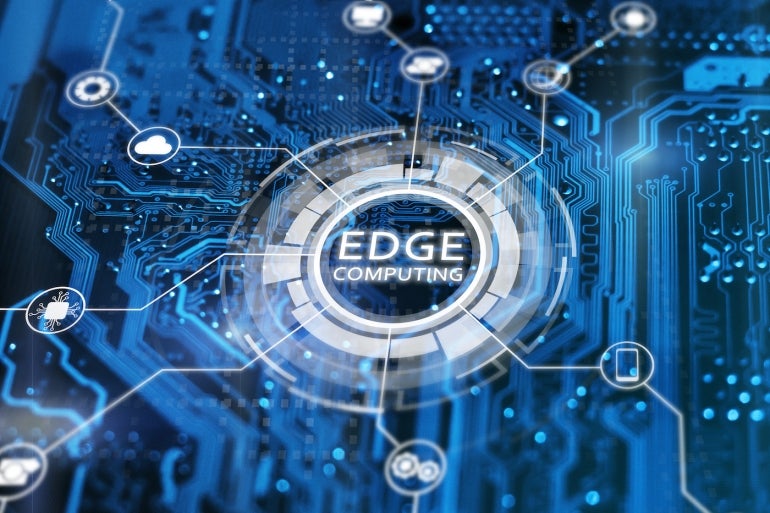
Edge computing is a diverse and growing field, as Deloitte has announced in its Technology, Media & Telecommunications 2023 Predictions report. Their predictions covered various themes and included an enterprise market growth of 22% in 2023, compared to 6% growth on overall enterprise IT in the same time period.
Edge and cloud computing
Edge computing allows the processing power to move closer to the consumer: Instead of servers being located at a central data center and all data being pushed out from there, edge computing might distribute compute power to end-user devices, cell towers or smaller, regional hubs to reduce latency.
SEE: Don’t curb your enthusiasm: Trends and challenges in edge computing (TechRepublic)
It’s likely organizations will invest in hardware first, with software and services following as the market matures, Deloitte said.
Cloud computing is an enabler of edge and has a lot of overlap in terms of which businesses embrace it. Deloitte notes that the edge reduces the expense and increases the efficiency of networking as opposed to “faraway clouds.” The more data people use — Deloitte predicts 175 zettabytes of data by 2025 — the more inefficient and expensive the cloud will become.
Types of edge organizations
Today, there are four major types of edge providers that all carve out their own part of the process.
Hyperscalers
Hyperscalers are organizations that have the architecture to scale to global range, such as Amazon or Facebook. For them, edge is seen as an addition to their existing cloud provider services, Deloitte said.
They also form partnerships with CSPs, content delivery networks, cell tower owners and others with highly distributed network facilities. They can use their partners’ distributed architecture to move closer to clients and/or end points.
Hyperscalers may pull back on their own cloud platforms in the future, instead delivering turnkey edge computing platforms on their customers’ hardware.
Communication service providers
CSPs such as Verizon and T-Mobile may also offer edge computing solutions. Sometimes they do so in collaboration with hyperscalers to connect the centralized clouds with the enterprise’s on-premise data centers, servers or devices. 5G networks can be used as part of a multi-access edge computing business to hook up to edge computing infrastructure.
Infrastructure equipment vendors
In turn, infrastructure equipment vendors may see a new opportunity open up. HPE, Cisco, Dell and other IT hardware vendors have recently offered new edge-to-cloud computing solutions. This often manifests as equipment vendors, which traditionally focused on hardware, now focus on software.
Edge cloud management
Edge cloud management platforms are also cropping up. These provide an abstraction layer to administer between deployment and the great variety of vendors and applications involved. The industry will likely see more centralized tools, KPIs and dashboards designed for diverse, hybrid environments.
Application programming interfaces are also common and becoming more standardized. Because they’re vendor-agnostic, they can promote interoperability. They also reflect the hardware-to-software trend, as network functions and capabilities are implemented through code rather than infrastructure more and more often.
Telecoms and the changing world
Deloitte predicts 5G networks will also be a major factor in the changing world of enterprise connectivity. 5G is in the spotlight, including “virtualized 5G.” This uses software-based network functions in place of some of those which were traditionally handled on hardware.
SEE: Hiring Kit: Network Engineer (TechRepublic Premium)
The current crop of mobile network operators investing in 5G could increase from more than 100 operators in 2022 to at least 200 by the end of 2023, Deloitte suggests.
“The markets for edge computing and private cellular networks are developing hand in hand,” Deloitte said.
Satellite debris and crowding problems
As of 2023, there will be approximately 5,000 broadband satellites in Earth’s orbit, Deloitte predicts. That could be a challenge for industry, as making space a common place for open use will require more and more collaboration between organizations. Space situational awareness, in-orbit satellite servicing and space debris removal may themselves be up-and-coming industries.
The reason: an increasing push for high-speed internet. Companies using commercial data satellites want to provide high-speed connectivity to customers across the globe. If all goes according to plan for the companies launching in LEO construction, there could be seven to 10 competing networks in operation by 2030, with 40,000 to 50,000 satellites in low Earth orbit.
‘Headwinds’ for edge
Edge adoption has slowed down a bit recently. Deloitte identifies several “headwinds” that may mean customers are slower to adopt these technologies and processes than the providers are to enable them. Companies will still need to evaluate exactly how to rearrange their cloud, data center and networking strategies, and determine which combination of methods works best for their individual needs.
Edge providers are also seeing a crowded playing field. Many form partnerships in anticipation of serving the same customers in the future. Each may provide a different value proposition or a different part of the pipeline instead of competing.
“The edge computing business will likely rely on partnerships and ecosystems and not on end-to-end solution providers in every case,” Deloitte said.
Finally, the edge computing industry is no more insulated from the general economy than any other.
“This year’s predictions underscore a common theme, both with consumers and businesses — to do more with less as inflationary pressures, supply chain issues and other world events continue to cause uncertainty,” said Kevin Westcott, vice chair at Deloitte.
Deloitte also recently released their list of top tech trends for 2022. Edge computing has existed as a variant on the server model since the early 2000s, and researchers are now exploring how to adapt it to the current developments in AI.